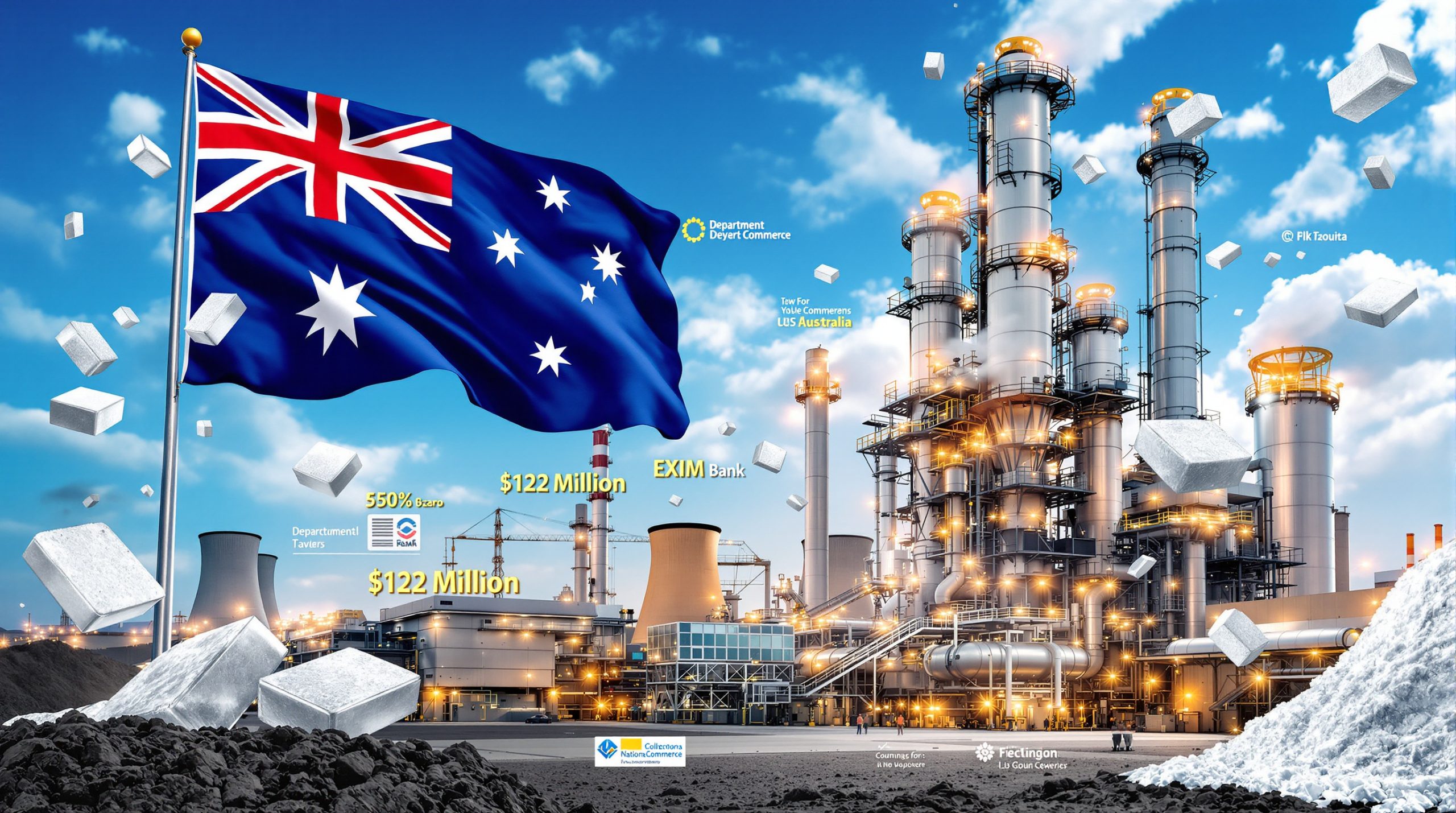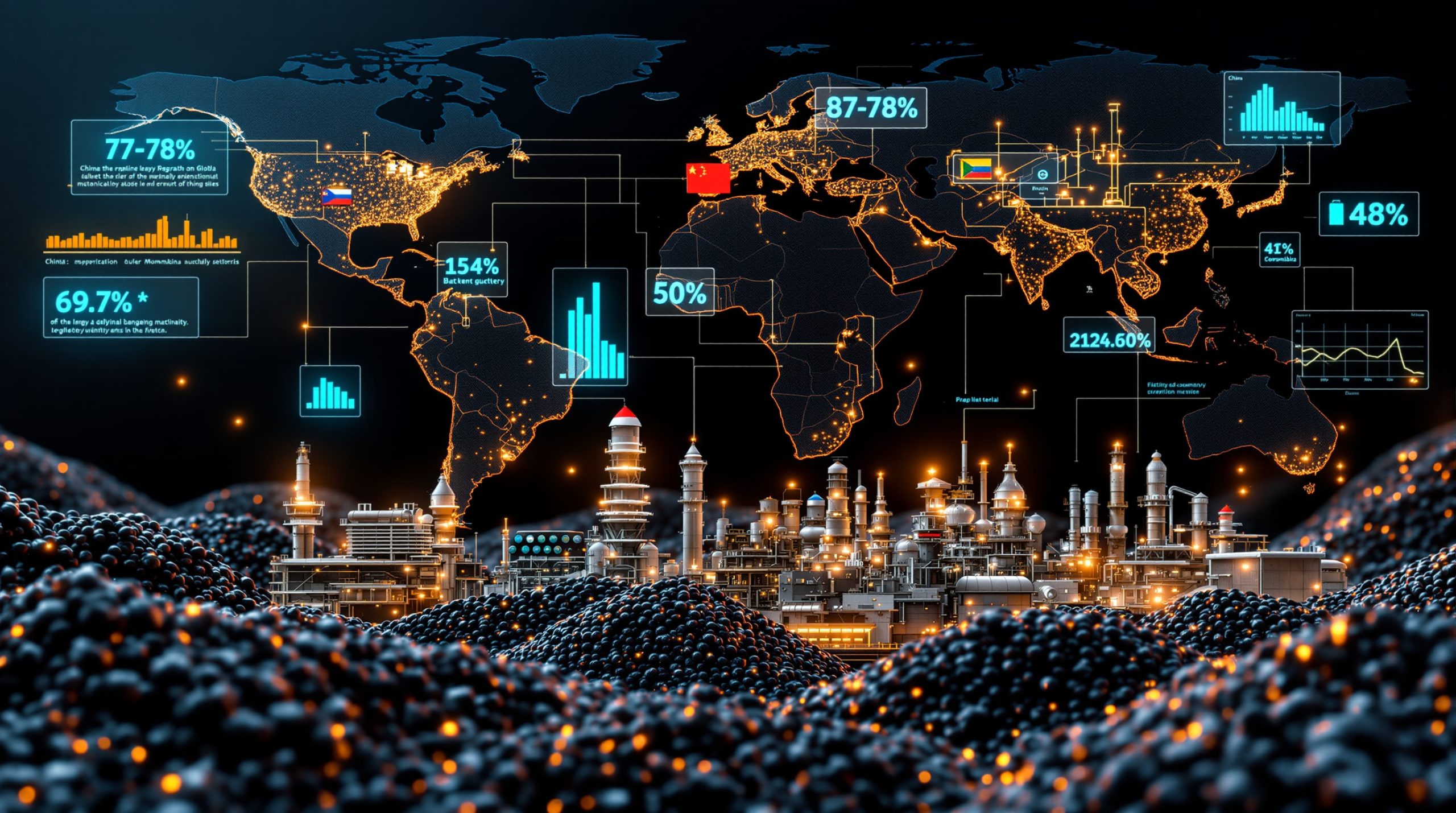What is China's Rare Earth Dominance?
China's control over rare earth elements represents one of the most successful resource consolidation strategies in modern industrial history. With approximately 90% of global rare earth processing capacity under its control, China has established an unparalleled position of strength in the global supply chain for these critical minerals. This dominance didn't emerge overnight but resulted from decades of strategic planning, government intervention, and technological development.
The country's commanding position gives it extraordinary leverage over global industries dependent on these materials, from consumer electronics to military applications. What makes China's strategy particularly effective is its comprehensive approach – controlling not just the mining operations but the entire value chain through to finished products.
The Strategic Importance of Rare Earth Elements
Rare earth elements (REEs) comprise 17 metallic elements on the periodic table with unique properties that make them indispensable in modern technology. Despite their name, most rare earths aren't particularly scarce in the Earth's crust, but economically viable concentrations are uncommon and processing them presents significant technical and environmental challenges.
These elements possess exceptional magnetic, luminescent, and electrochemical properties that cannot be easily replicated with substitute materials. Their applications span critical sectors:
- Defense: Precision-guided munitions, radar systems, night vision devices
- Renewable Energy: Wind turbine generators, solar panel components
- Electronics: Smartphones, hard drives, speakers, vibration motors
- Automotive: Electric vehicle motors, catalytic converters, sensors
- Medical Technology: MRI machines, surgical tools, diagnostic equipment
China's Market Share in Numbers
China's dominance of the rare earth sector is reflected in these key statistics:
- 90% of global processing capacity is concentrated within Chinese borders
- Over 70% of raw rare earth production comes from Chinese mines
- Complete control of the midstream separation processes for many critical elements
- Dominant position in manufacturing components containing rare earths
- Strategic reserves estimated to be sufficient for multiple years of global demand
This level of market concentration gives China unprecedented control over materials essential for industries worth trillions of dollars globally. The strategic implications extend far beyond economics into geopolitics, military readiness, and energy security for nations worldwide.
How Did China Transform Its Rare Earth Sector?
China's journey to rare earth dominance represents a masterclass in strategic resource management. When China restricted rare earth exports to Japan during a 2010 diplomatic dispute, its domestic industry was largely chaotic and unregulated. Smuggling was rampant, environmental damage widespread, and Beijing had limited actual control over the sector despite its natural resource advantages.
In the years since, China has implemented a comprehensive critical minerals strategy that transformed this fragmented industry into a powerful economic and geopolitical tool. The process involved simultaneous crackdowns on illegal operations, industry consolidation, environmental remediation, and strategic export controls.
From Hundreds to Just Two: The Consolidation Strategy
The most dramatic change in China's rare earth industry has been the massive consolidation of mining and processing operations:
- 2010: Hundreds of miners and processors operated independently throughout China
- 2013: Beijing had reduced the industry to just ten authorized producers
- 2025: Only two state-owned giants now dominate the entire sector:
- China Rare Earth Group (controlling southern deposits rich in heavy rare earths)
- China Northern Rare Earth Group High-Tech (controlling northern light rare earth resources)
"The decade-plus process of consolidation gave Beijing greater oversight while also curbing some of the environmental damage caused by illegal and reckless mining," explains David Abraham, affiliate professor at Boise State University and rare earths expert.
This consolidation process, spanning over 15 years, gave the Chinese government unprecedented control over production volumes, pricing, and strategic allocation of these critical resources. It also addressed some of the environmental catastrophes caused by unregulated mining operations that had severely damaged local ecosystems.
The Elimination of Illegal Supply Chains
Prior to the consolidation, China's rare earth sector featured extensive illegal operations that undermined government control:
- Unauthorized miners extracted ore from remote locations
- Unregulated facilities processed the materials without environmental safeguards
- Finished products were disguised and exported through complex smuggling networks
- Tax evasion was rampant throughout the supply chain
In 2014 alone, approximately 40,000 metric tons of rare earth oxides were smuggled overseas—50% more than official export figures. This illegal trade not only reduced government revenue but prevented Beijing from exercising strategic control over these critical resources.
The government's response included coordinated raids on illegal operations, strict environmental enforcement, and a sophisticated tracking system that has virtually eliminated unauthorized production. The resulting supply chain is now tightly controlled from mine to market.
What Quota Systems Control China's Rare Earth Production?
Beyond industry consolidation, China has implemented sophisticated quota systems to regulate production and exports, further tightening its grip on the global supply chain. These quotas serve both economic and strategic purposes, allowing China to balance domestic needs with global market conditions while maintaining leverage over technology-dependent nations.
The Evolution of Production Quotas
China introduced its production quota system in 2006, covering three key areas of the supply chain:
- Mining quotas: Controlling the extraction of raw rare earth ores
- Smelting quotas: Limiting the initial processing of concentrated materials
- Separation quotas: Restricting the production of individual rare earth oxides
These quotas, typically issued twice yearly, serve as critical indicators for global supply forecasts and pricing trends. Industry analysts monitor them closely as barometers for China's strategic intentions regarding rare earth reserves.
Over time, access to these quotas has become increasingly restricted:
- Pre-2024: Six companies were eligible for production quotas
- 2024: Only the two state-owned groups remain eligible (China Rare Earth Group and China Northern Rare Earth Group High-Tech)
This narrowing of quota eligibility has further centralized control under entities directly answerable to Beijing, eliminating even the limited competition that existed previously.
Strategic Control of Supply Growth
China has deliberately managed supply growth in recent years to maintain price stability and strategic leverage:
- 2023: Total mining output quota increased by 21.4% year-on-year
- 2024: Growth slowed dramatically to just 5.9% year-on-year
- 2025 (projected): Analysts expect quotas to either remain flat or increase by no more than 5%
This careful calibration of supply growth allows China to maintain price levels that are profitable for domestic producers while avoiding shortages that might accelerate alternative source development in other countries.
Technology Export Restrictions
Beyond controlling physical materials, China restricts the export of rare earth processing technology and expertise:
- Long-standing bans on extraction and separation technology transfers
- In late 2023: Extended export bans to include technology used in rare earth magnet production
- Restrictions on technical know-how and equipment sales to potential competitors
These technology export controls effectively prevent other countries from developing competitive processing capabilities, even if they have their own rare earth deposits. The technical expertise and equipment needed for efficient separation and processing remain largely within Chinese borders.
What Happened When China Imposed New Restrictions in 2024?
The effectiveness of how China tightened its grip over its rare earth sector became evident in April 2024, when new export restrictions had immediate global impacts. Unlike the 2010 situation, when smuggling and workarounds diminished the effect of formal restrictions, the 2024 measures demonstrated China's near-complete control over global supply chains.
Immediate Global Supply Chain Disruption
Within just two months of China's April 2024 export restrictions:
- Global automakers faced critical shortages of rare earth materials for EV motors
- Several manufacturers were forced to pause production lines
- Supply chain disruptions rippled through high-tech industries worldwide
- Alternative suppliers couldn't fill the gap due to limited processing capacity outside China
- Prices for key rare earth oxides increased by double-digit percentages
The swift and severe market reaction demonstrated the vulnerability of global industries to China's rare earth policies. Unlike previous restrictions, the consolidated and tightly regulated industry structure left few alternatives for manufacturers.
The Magnet Sector Tracking System
While China's upstream mining and refining sectors have consolidated dramatically, the downstream magnet manufacturing sector remains somewhat more fragmented, with dozens of producers across China, including major players like JL Mag Rare-Earth and Ningbo Yunsheng.
To address this relative fragmentation, China introduced a comprehensive tracking system for rare earth magnets in June 2024, requiring:
- Detailed customer information for every transaction
- Complete reporting of transaction volumes and specifications
- End-to-end supply chain visibility from raw materials to finished products
- Compliance verification with national strategic objectives
- Export destination tracking and approval processes
This tracking system extends China's control throughout the value chain, ensuring that even the more numerous magnet manufacturers operate in alignment with national strategic goals. It also provides unprecedented visibility into global technology supply chains that depend on these components.
How is China Extending Control Across the Entire Rare Earth Value Chain?
China's strategy extends far beyond raw materials to encompass the entire value chain, from mining to finished products incorporating rare earth elements. This comprehensive approach creates multiple layers of control and influence over global industries.
Vertical Integration of Critical Industries
The Chinese government has strategically integrated rare earth operations with downstream manufacturing:
- Electric vehicle production: Partnerships between rare earth processors and EV manufacturers
- Renewable energy equipment: Vertically integrated wind turbine production using domestic rare earths
- Advanced electronics: Preferential supply arrangements for domestic manufacturers
- Defense technology: Secured supply chains for military applications
- Medical equipment: Integrated production of diagnostic and treatment devices
This vertical integration ensures that China not only controls the raw materials but also captures the value-added throughout the manufacturing process. It also creates resilience against external pressure, as critical industries have secured supply regardless of global market conditions.
Strategic Export Controls on Finished Products
China's control extends to selective regulation of finished products containing rare earth elements:
- Carefully calibrated export restrictions on high-value products
- Preferential access to materials for domestic manufacturers
- Strategic allocation of materials to priority industries and national champions
- Leveraging access to materials for diplomatic and trade advantages
- Ability to disrupt competitor nations' manufacturing at multiple points in the supply chain
This multi-layered approach gives China unprecedented flexibility in exercising its resource power. Rather than crude embargoes, it can apply precise pressure at various points in the supply chain to achieve specific diplomatic or economic objectives.
What Are the Global Implications of China's Rare Earth Dominance?
China's tight control over rare earth elements has profound implications for global industries, national security, and geopolitical relationships. As technology continues to advance, dependence on these materials is likely to increase rather than decrease, potentially amplifying China's leverage.
Supply Vulnerabilities for Critical Industries
The concentration of rare earth processing in China creates significant vulnerabilities for:
- Automotive manufacturers: Particularly EV producers dependent on NdFeB magnets
- Renewable energy developers: Wind turbines require up to 600kg of rare earths per megawatt
- Consumer electronics companies: Reliant on rare earths for miniaturization and performance
- Defense contractors: Vulnerable to supply disruptions for critical weapons systems
- Aerospace manufacturers: Dependent on rare earths for multiple components
These vulnerabilities extend beyond individual companies to national economic security, particularly as countries pursue electrification and renewable energy targets that increase surging critical minerals demand. A prolonged supply disruption could derail climate goals and industrial policies worldwide.
Geopolitical Leverage in International Relations
China's rare earth dominance provides significant diplomatic leverage:
- Can selectively restrict access during trade disputes or geopolitical conflicts
- May use access as a negotiating tool in international relations on unrelated issues
- Creates dependencies that influence foreign policy decisions by other nations
- Potentially impacts national security considerations and military readiness
- Offers China subtle influence without resorting to more provocative measures
This leverage is particularly potent because it can be applied with precision to specific companies or sectors, rather than blunt instrument sanctions that might provoke more severe counterreactions.
Industry Note: China has been careful to use its rare earth leverage sparingly and strategically, understanding that excessive use would accelerate efforts to develop alternative supplies. The 2010 and 2024 restrictions demonstrated capability without creating a sustained crisis that might undermine China's long-term position.
How Are Other Countries Responding to China's Rare Earth Dominance?
As awareness of supply vulnerabilities grows, countries and companies worldwide are developing strategies to reduce dependence on Chinese rare earth supplies. These efforts face significant challenges in replicating the scale, expertise, and infrastructure that China has developed over decades.
Diversification Efforts Outside China
Several initiatives aim to develop alternative supply chains:
- Australia: Lynas Rare Earths has become the largest non-Chinese producer, with processing facilities in Malaysia and Australia
- United States: Restarted production at Mountain Pass mine in California with government support
- Canada: Developing multiple deposits with strategic investment from allies
- European Union: Launched the European raw materials supply alliance to reduce dependence
- Japan: Invested in overseas projects and strategic partnerships with Australia
These efforts face common challenges including higher production costs, environmental permitting obstacles, and the need to develop processing expertise that China has refined over decades. Most projects require significant government support to remain viable against Chinese competition.
Technological Alternatives and Recycling
Research into reducing rare earth dependence includes:
- Developing alternative materials with similar properties but different elemental compositions
- Improving recycling technologies to recover rare earths from electronic waste
- Designing products that require fewer rare earth elements or use more common substitutes
- Creating closed-loop supply chains to maximize resource efficiency
While promising, most of these approaches remain either technically challenging or economically uncompetitive with China's established supply chains. Recycling in particular faces significant obstacles due to the dispersed nature of rare earths in finished products and the complex processes required to recover them.
FAQs About China's Rare Earth Dominance
What are rare earth elements and why are they important?
Rare earth elements comprise 17 metallic elements with unique magnetic, luminescent, and electrochemical properties. Despite their name, most aren't particularly rare in the Earth's crust, but economically viable concentrations are uncommon. They're essential components in technologies including smartphones, electric vehicles, wind turbines, and military equipment.
Could other countries challenge China's rare earth dominance?
While several countries possess rare earth deposits, challenging China's dominance requires more than mining capacity. The complex processing infrastructure, technical expertise, and integrated supply chains developed over decades give China significant advantages. Countries like Australia, the United States, and Canada are working to develop alternative supply chains, but establishing competitive processing capacity will take years and substantial investment.
How do rare earth restrictions impact global industries?
Restrictions on rare earth exports can quickly disrupt global supply chains for high-tech manufacturing. The 2024 restrictions demonstrated how rapidly shortages can impact production, with some automakers forced to pause manufacturing within two months. Industries particularly vulnerable include electric vehicles, wind turbines, electronics, and defense technology.
What environmental concerns surround rare earth processing?
Rare earth processing has significant environmental impacts, including:
- Toxic and radioactive waste generation
- Heavy water consumption
- Chemical pollution risks
- Land degradation from mining
- Energy-intensive processing requirements
China's consolidation efforts have partly addressed environmental issues from illegal operations, but sustainable processing remains a global challenge.
Further Exploration
Readers interested in learning more about this topic can also explore related educational content about rare earth elements, global supply chains, and critical minerals energy transition across various sectors of strategic importance.
Want to Discover the Next Major Mining Opportunity?
Discovery Alert's proprietary Discovery IQ model instantly analyses ASX announcements to identify significant mineral discoveries before the broader market, transforming complex data into actionable investment insights. Explore how these discoveries can generate substantial returns by visiting the dedicated discoveries page and position yourself ahead of the market.




